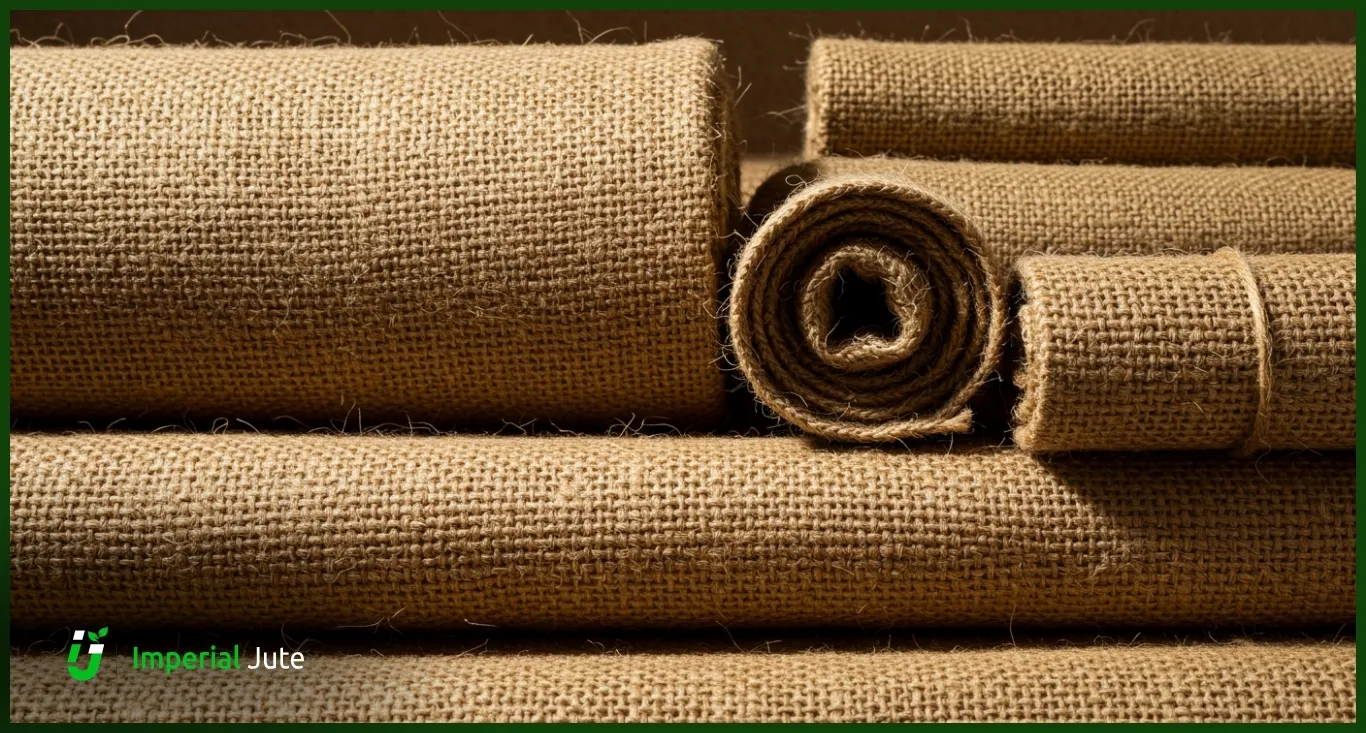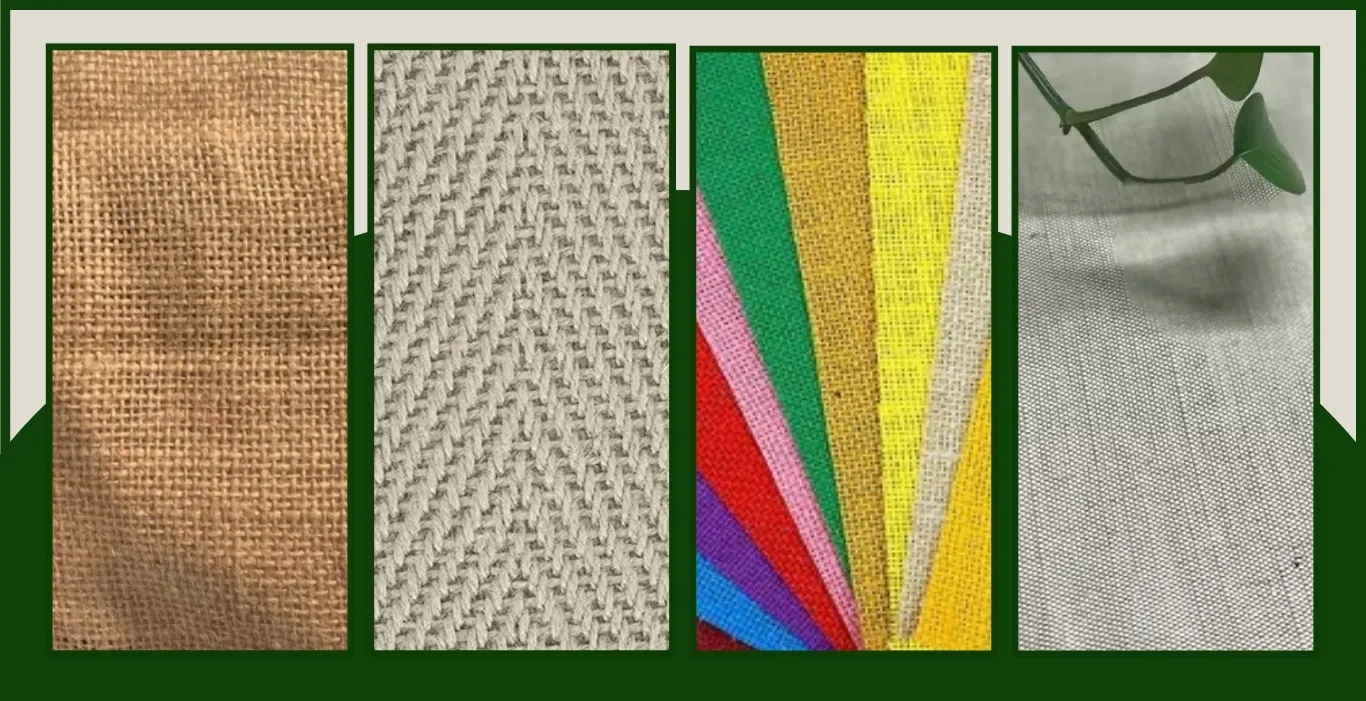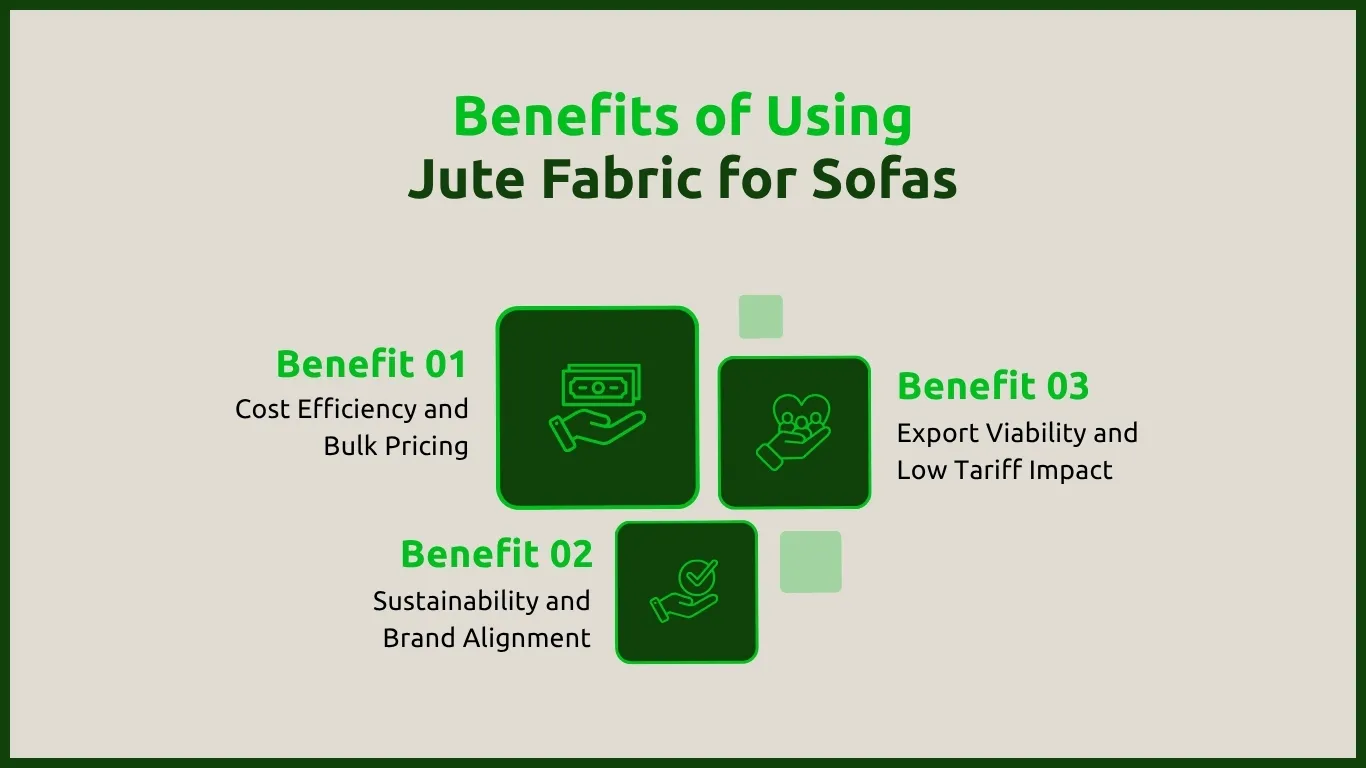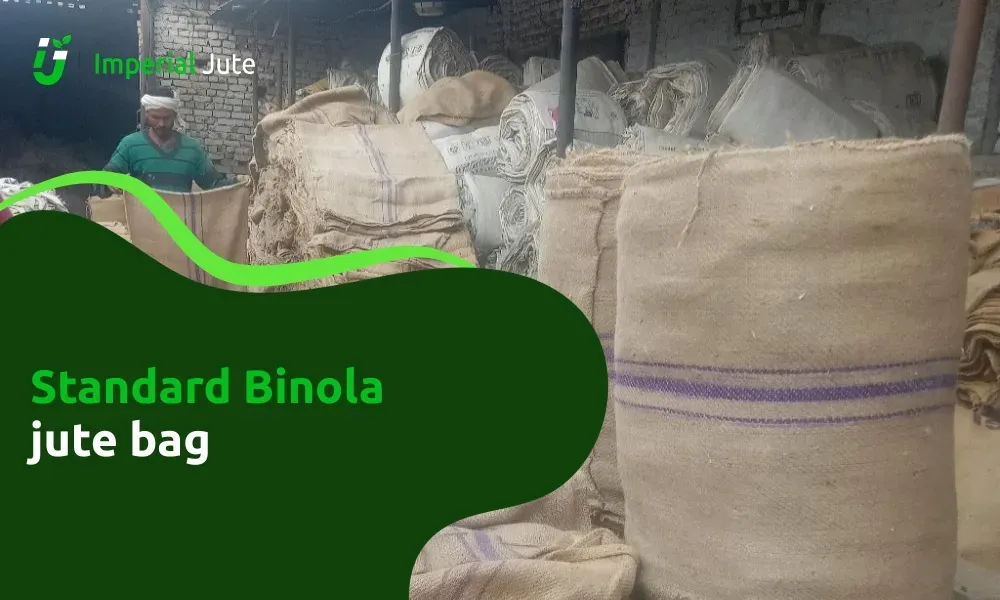Global demand for sustainable upholstery materials is rising, with jute fabric gaining traction across commercial and residential furniture markets. According to the IJSG, jute exports increased by over 20% in 2023, driven by the shift toward biodegradable and low-impact materials. In furniture manufacturing, jute’s high tensile strength, breathability, and low cost per meter make it a practical alternative to cotton or synthetics. It is especially popular in B2B supply for sofas due to its durability in high-use environments and alignment with eco-certifications like OEKO-TEX and GOTS. This article examines its suitability for upholstery, explores types of jute fabric, and addresses sourcing factors relevant to wholesale buyers.
What Makes Jute Fabric an Ideal Choice for Sofa Upholstery?
Jute is suitable for sofa upholstery because it balances visual texture with natural strength, making it ideal for both residential and commercial use.
Jute fibers are long, coarse, and strong by nature. This gives the fabric high tensile strength, which allows it to handle regular sitting pressure without easily tearing or sagging. When used in sofas, especially in high-use environments like lounges, hotels, or public waiting areas, jute maintains structural integrity over time.
Visually, jute provides a raw, earthy appeal that is increasingly popular in minimalist, rustic, or Scandinavian interior designs. Its naturally golden-brown tones blend easily with both muted and vibrant color palettes.
Performance-wise, jute is naturally anti-static and less prone to collecting dust compared to synthetic materials. This is particularly helpful for public-use sofas where cleanliness and reduced allergen accumulation are crucial.
In hot and humid environments, jute’s breathability and moisture-wicking properties help reduce heat retention in the fabric, offering a more comfortable sitting experience. These characteristics make jute not just a visual trend, but a functional upholstery solution in real-world usage.
Is Jute Fabric Good for Sofas?

Yes, jute fabric is a good choice for sofas when performance, durability, and sustainability are important.
Its fiber structure contains high cellulose and lignin content, which gives jute tensile strength similar to low-density polyester. In practice, this means jute fabric can hold its shape well, especially in the base upholstery of cushions, arms, and backrests.
Jute’s coarse surface also adds tactile depth, offering a natural resistance to slipping or bunching up on cushions. For furniture that needs to look structured without sagging or creasing, this is an advantage.
Another practical trait is its natural dust-repellent quality. Jute does not attract static electricity, which means it gathers far less airborne dust than polyester or nylon. This keeps sofa surfaces cleaner over time, making it a low-maintenance option for commercial settings.
When jute is laminated or blended with cotton or polyester, it becomes even more furniture-friendly—less itchy, more flexible, and easier to clean. These treatments solve one of the most common objections to using jute in home or hospitality settings.
For durability, jute used in upholstery generally lasts 3 to 7 years depending on GSM, usage, and whether it’s coated. With the right maintenance, it performs comparably to more expensive synthetic blends.
How Jute Compares to Cotton, Linen, and Synthetic Upholstery
Jute holds its ground well against cotton, linen, and synthetics in terms of durability and environmental performance, though each has its own trade-offs.
Cotton upholstery is soft, breathable, and widely available. However, cotton tends to lose shape with heavy use and requires frequent cleaning. It also consumes high water and pesticide input during cultivation, making it less eco-friendly overall.
Linen offers a smoother texture and luxurious feel, but it’s prone to wrinkling and requires professional care. While both linen and jute are biodegradable, jute production emits significantly less CO2 per ton due to lower water requirements and faster crop cycles.
Synthetic fibers like polyester are stain-resistant and color-stable, but they lack breathability and are derived from petroleum, raising environmental concerns. These fabrics may off-gas VOCs (volatile organic compounds), which is a problem in indoor furniture environments.
In contrast, jute absorbs more moisture than polyester but less than cotton or linen. It retains color well when dyed but may fade under prolonged direct sunlight unless treated.
Most importantly, jute’s environmental profile is stronger than any of the above. It grows without chemical fertilizers and consumes 80% less water than cotton. According to the FAO, jute absorbs around 15 tonnes of carbon dioxide per hectare during growth.
This positions jute as not just a functional fabric but a responsible choice in sustainable manufacturing.
Different Types of Jute Fabric Used for Sofas

Jute fabrics used in sofas vary in weave, finish, and material composition. Each type serves a different functional or aesthetic purpose in upholstery, especially in high-traffic furniture or export-oriented design.
Here are the most common types of jute fabric used for sofas:
Plain Weave Jute:
This is the most basic and durable form of jute cloth. It features a tight, grid-like pattern that offers high tensile strength, making it suitable for cushion backing, sofa bases, and structural upholstery.
Twill Weave Jute:
Twill jute has a diagonal rib pattern that provides a softer hand feel and more flexibility. It’s often used on visible parts of the sofa, such as armrests or seat surfaces, where comfort and finish are important.
Coated or Laminated Jute:
This type comes with PU (polyurethane) or latex backing. The coating makes the fabric more resistant to dust, stains, and moisture, which is ideal for commercial or hospitality settings. Laminated jute also reduces surface roughness.
Blended Jute Fabric:
Jute is sometimes blended with cotton, polyester, or viscose to improve flexibility and softness. Common blends include 60:40 (jute to cotton) or 70:30 (jute to polyester). These are preferred in applications requiring finer stitching or decorative finishes.
Dyed and Pre-Shrunk Jute:
For sofa manufacturers focusing on branding or interior color schemes, jute is available in custom-dyed formats. Pre-shrunk versions also reduce fabric deformation during stitching or cleaning.
Each type offers unique benefits depending on the sofa design, expected wear, and buyer preferences, whether for rugged durability, ease of maintenance, or aesthetic appeal.
Jute Sofa Cover Fabric: Ready Stock vs Custom Bulk Supply
Jute sofa cover fabric is available in both ready-stock rolls and custom bulk production options, depending on the buyer’s needs. The right format depends on production scale, desired specifications, and supply timelines.
Ready Stock Jute Fabric for Sofa Covers
Ready stock refers to pre-woven jute fabric rolls available in standard GSM (typically 200–350), widths (44 to 60 inches), and weaves like plain or twill. These are suitable for manufacturers, upholstery units, or exporters who require smaller batches or faster turnaround times. The fabric is usually undyed or neutrally toned, allowing flexibility in downstream processing.
Buyers choose ready stock when they want to prototype designs, fulfill small orders, or test fabric compatibility without committing to large volumes. While affordable and convenient, customization options like printing, lamination, or pre-shrinking may be limited.
Custom Bulk Jute Sofa Fabric Orders for B2B Buyers
Large-scale manufacturers and fabricators often require jute sofa fabric tailored to specific specifications, such as custom GSM, weave density, width, or chemical treatment. These bulk orders are made-to-order, with a minimum quantity of 300 to 1,000 meters, depending on the mill.
Custom orders also offer optional finishing treatments like PU lamination, water repellency, flame resistance, and digital or screen printing. Lead times typically range from 15 to 30 days depending on order size and finishing requirements.
This option is ideal for furniture brands, OEM upholstery producers, and exporters needing consistent quality, branding compatibility, and compliance with international standards like REACH or OEKO-TEX. It also minimizes fabric waste and enables better control over shrinkage, texture, and performance characteristics.
Benefits of Using Jute Fabric for Sofas in B2B Settings

Jute fabric offers furniture businesses a unique combination of economic value, ecological responsibility, and commercial feasibility, especially when purchased at scale for upholstery applications.
Cost Efficiency and Bulk Pricing
Jute is one of the most affordable natural fibers on the market. According to trade data, raw jute costs around $0.60 to $0.90 per meter (at 200–300 GSM), significantly lower than dyed cotton or performance polyester blends. Due to its durability, the fabric lasts longer in sofa applications, reducing the total lifecycle cost. For bulk buyers, large orders benefit from consolidated shipping, localized dyeing, and low per-unit cost, especially when sourcing directly from exporting countries like Bangladesh or India.
Sustainability and Brand Alignment
Jute’s biodegradability and low-impact cultivation make it a strong fit for brands focused on eco-conscious manufacturing. Jute farming uses little to no synthetic pesticides and helps absorb large amounts of CO₂ from the atmosphere—up to 15 tons per hectare per season. Many B2B buyers use jute to meet global sustainability frameworks like the UN SDGs, LEED certification, or ISO 14001 standards. Using jute also opens doors to premium markets, especially in the EU, where consumers prefer certified green materials.
Export Viability and Low Tariff Impact
Jute products often qualify for favorable trade terms under Generalized System of Preferences (GSP) schemes, especially when exported from South Asian countries. For example, jute upholstery fabric entering the EU market enjoys reduced tariffs under the EBA (Everything But Arms) arrangement. This makes bulk jute sourcing commercially attractive for furniture exporters who need cost efficiency along with sustainable materials.
Where to Source High-Quality Jute Cloth in Bulk
Reliable sourcing of jute fabric is essential for consistent upholstery quality and large-scale manufacturing success. Buyers must consider factors like weave consistency, export capacity, and compliance standards.
What to Look for in a Jute Fabric Manufacturer
A dependable manufacturer should offer accurate GSM grading (commonly 200–350 GSM for upholstery), consistent weaving, and color uniformity. Testing for rub count (e.g., Martindale 15,000–25,000 cycles), pilling, shrinkage (under 3%), and UV resistance is also critical for performance-based applications.
Buyers should request fabric swatches and technical datasheets before placing orders. Manufacturers who offer third-party testing—like SGS, BV, or TÜV certifications—can ensure fabric integrity for export compliance and long-term use.
MOQ, Lead Time & Export Capabilities
Most B2B jute suppliers offer MOQs ranging from 300 to 1,000 meters depending on weave and finish. Lead times typically fall between 15 to 30 working days. Export-ready suppliers should also provide proper packaging (baled or rolled), labeling, and documentation support, including phytosanitary certificates or country-of-origin declarations if required.
Bangladesh as a Global Hub for Jute Fabric Export
Bangladesh leads global jute exports, contributing over 70% of the world’s jute fabric supply according to the International Trade Centre. The country hosts hundreds of vertically integrated mills that specialize in upholstery-grade jute, often equipped with dyeing, calendaring, and coating facilities.
Its government-supported export logistics and favorable trade agreements with the EU, UK, and Canada make Bangladesh a competitive sourcing destination. The country’s jute industry is also increasingly aligning with international standards such as OEKO-TEX 100 and ISO 9001.
Frequently Asked Questions
Buyers exploring jute for upholstery often have concerns about texture, durability, and treatment options. This section answers the most common queries based on real-world use cases and fabric performance standards.
Is jute itchy or rough for use on a sofa?
Unfinished jute can feel coarse, but treated or laminated versions offer a much smoother finish. Blends with cotton or polyester reduce roughness while maintaining jute’s structural integrity. In commercial settings, laminated jute with PU or latex backing is commonly used to avoid direct skin contact, making it comfortable enough for daily use.
How long does jute upholstery last?
Jute fabric used in sofas generally lasts between 3 to 7 years, depending on GSM, weave, and environmental exposure. Higher-GSM and coated varieties withstand abrasion better, particularly in public or high-traffic spaces. Regular dry brushing and minimal water exposure help maintain fabric integrity over time.
Can jute fabric be dyed or printed?
Yes, jute takes well to reactive dyes, pigment prints, and screen printing methods. However, due to its natural lignin and cellulose composition, it may absorb color unevenly unless pre-treated. Modern processing techniques have improved colorfastness, allowing customized branding, patterns, or corporate-themed upholstery.
Is jute fire-resistant or can it be treated?
Raw jute is flammable, but it can be made fire-retardant with industry-approved treatments. Coatings using borax, ammonium phosphate, or silicone-based compounds are common in hospitality-grade upholstery. Always verify that fire-retardant fabric meets standards like BS 5852 (UK) or CAL 117 (USA) before use in regulated environments.
Conclusion
Jute fabric is proving its value in sofa upholstery for businesses seeking a balance of durability, aesthetics, and environmental responsibility. From plain weave to coated and blended options, its versatility fits a wide range of commercial and residential furniture needs.
With increasing global pressure to adopt sustainable materials and transparent sourcing practices, jute offers a future-proof solution. Its natural origin, biodegradability, and affordability make it an asset for furniture makers, retailers, and interior suppliers alike.
Choosing the right type of jute, understanding supplier capabilities, and aligning with relevant certifications are critical for maximizing its benefits in B2B upholstery settings. When these factors are accounted for, jute fabric can elevate both the sustainability profile and functional value of sofa products on a global scale.

